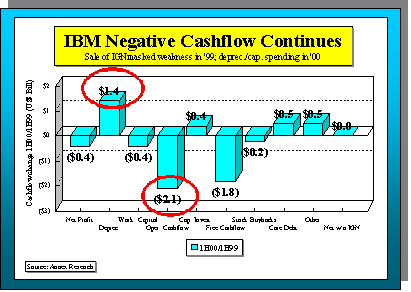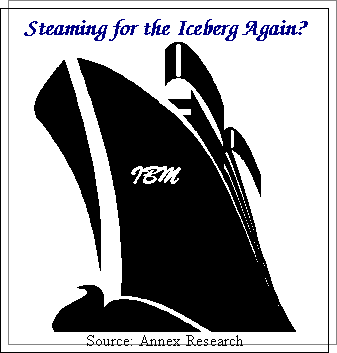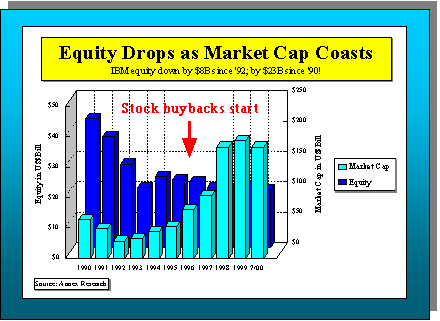|
Analysis
of IBM’s Second Quarter Business Results
IBM
Smoke and Mirrors Game
IBM Continues to Woo and Wow Gullible Wall Street
PHOENIX, July
19 – You have to hand it to Armonk shysters. For God-only-knows how many quarters now, they’ve managed to
pull a rabbit out of the hat; to put a new twist to an old game of
financial smoke and mirrors.
Never mind that IBM revenues and earnings declined in
the latest quarter. Or that
the company’s cashflow dropped by $2.1 billion.
Nor that its equity has now sagged to $19.2 billion, down more than
$8 billion since Lou Gerstner took over as IBM CEO in 1993; and down more
than $23 billion since 1990. Look
for the Bug Blue stock to shoot up tomorrow.
Probably, way up…
Why? It
takes two to tango. It takes
two to make a scam work. It
takes a cheeky Armonk. And it
takes a gullible Wall Street. We
witnessed both of them at their best today.
Or their worst, depending on your point of view.
In IBM’s teleconference for analysts and media
which followed a release of the company’s second quarter results after
the markets closed this afternoon, the Big Blue’s CFO, John Joyce gave a
dazzling performance. It was
only exceeded by the meekness and/or stupidity of questions asked by the
Wall Street folks who earn six-digit salaries telling their investors what
they want to hear.
Joyce opened with a chart that showed a truly
staggering $20.3 billion in new business signings by IBM Global Services,
the company’s brightest shining star of the 1990s.
It was only later on, during the question and answer period, that
Joyce cautioned the analysts not to expect an encore of such an amazing
performance any time soon. Meaning,
that the Big Blue may have borrowed from the future to pad its present and
the past?
By that stage, however, who cared about real facts?
The impact of a bombastic “front
 page”
headline had already sunk in the gullible Wall Street analysts mind. From
their on, they were only to parrot the IBM CFO’s one-liners, rather than
analyze the results and form independent opinions of their own. page”
headline had already sunk in the gullible Wall Street analysts mind. From
their on, they were only to parrot the IBM CFO’s one-liners, rather than
analyze the results and form independent opinions of their own.
So impressive was Joyce “accounting magic” that
the IBM CFO may be wasting his time +and talents conning the mere Wall
Street analysts. My, can you
imagine what a man with shystering instincts like that could do for
Hillary Clinton, for example, not to mention for political lackeys like
“Algore” or “Dubya?”
Negative
Cashflow Continues
For the time being, however, Joyce’s pontifications
evidently sufficiently mesmerized and distracted the Wall Street analysts
from noticing some deep crevices in IBM’s financial statements. Such as the fact that the company’s negative cashflow
continues unabated, for example. Meaning
that “Gerstner, Joyce & Co.” are spending their “children’s”
inheritance like there is no tomorrow.
Which is probably an accurate statement - for both
the IBM shareholders, the “children” in this equation, and Armonk’s
current leaders.
During the first half of 2000, for example, IBM
business operations contributed $2.1 billion less (!) to its till as
compared to the first half of 1999 ($3.3 billion vs. $1.2 billion).
After the capital expenditures and other investments
are taken into account, the Big Blue’s free cash flow during the first
six months of this year was a negative $1 billion, or a negative $1.8
billion compared to the first half of 1999.
By the way, one reason IBM was able to create an
illusion of prosperity even a year ago, when things seemed a lot rosier
for the Big Blue, was its $5 billion sale of the IBM Global Network to
AT&T. In the second
quarter of 1999, this transaction meant a net $4.1 billion cash infusion
to IBM. Without it, IBM’s
cashflow a year ago would have been a negative $2.6 billion, just as it
was in the first six months of 2000. ago, when things seemed a lot rosier
for the Big Blue, was its $5 billion sale of the IBM Global Network to
AT&T. In the second
quarter of 1999, this transaction meant a net $4.1 billion cash infusion
to IBM. Without it, IBM’s
cashflow a year ago would have been a negative $2.6 billion, just as it
was in the first six months of 2000.
So IBM continues to sell off its “children’s
inheritance,” while trying to create an illusion of prosperity, to the
applause of Wall Street, and to a stunning silence of gullible investors.
It’s all reminiscent of the “Great IBM Lease Base Sale” some 20
years ago, about which this writer questioned the IBM chairman at the 1997
Annual Meeting in Dallas (see Appendix A).
Product
Segment Analysis
What Armonk’s “smoke and
mirrors” expert (Joyce) also focused on was a “strong Web server
growth.” But he did it
without bothering to define either what these “Web servers” were, or
what sort of a growth he was referring to (revenue, or…?).
When questioned by an analyst about
what products he considered to be “Web servers,” Joyce basically
replied with “yes.” Meaning
just about anything that touches the Internet is considered a “Web
server” by IBM.

Meanwhile, some IBM “servers” in
the traditional sense of that word - the S/390 and AS/400 computers - both
experienced double-digit revenue declines in the latest quarter.
The AS/400’s drop was particularly precipitous, down 23% from,
the year before. Joyce blamed
most of that on a “product transition” (meaning that a new AS/400 line
of products is due to ship at the end of this month).
The S/390s, the “mainframes” by
the old nomenclatures, also experienced a double-digit drop in revenues
despite a 1% increase in MIPS shipments, the first such an up-tick
following three quarters of MIPS declines.
As for IBM Global Services, the IBM
CFO was quick to point out that the Big Blue’s latest new contract
signings ($20.3 billion) supposedly represented three times the combined
total of the next two largest competitors’ new business deals - EDS’s
and CSC’s.
Joyce said that IBM had signed 20
contracts valued at $100 million or more (generally referred to in the
industry jargon as “megadeals”), and that three of them were worth $1
billion or more.
As to why such a splendiferous
performance resulted in only a 2.5% increase in the IBM (non-maintenance)
services revenues, the IBM CFO said that the terms of the $20 billion of
new contracts were generally about 10% longer than was the case before.
Anyone
with a simple calculator could have realized that was a hogwash answer.
But Wall Street is evidently stacked with hogs.
Or out of calculators. Thus
no audible objections were raised about this example of persuasion by
evasion.
Furthermore, when an analyst
questioned the IBM CFO to elaborate on how IBM Global Services was doing
beyond the top-tier “megadeals,” Joyce also evaded the question.
For which the gullible analyst even thanked him!?
What we think, therefore, is that IBM
is continuing to win the cream of the crop of the largest outsourcing
deals, those with lowest margins. Sooner
or later, such a focus on the high-end customers, coupled with mortgaging
of the company’s future, will catch up with the Big Blue.
By which stage, however, its “easy riders,” such as Lou
Gerstner or John Joyce, will have disappeared into the sunset.
Leaving the gullible shareholders holding the bag.
No
surprises there. Just look at
how the IBM equity dropped as its market capitalization soared during the
last five years. It was a
classic case of selling off the “children’s inheritance.”
Which, of course, is small potatoes compared to Wall Street’s
dot-com craze.
Happy
bargain hunting!
Bob
Djurdjevic
Appendix
A
(from
Annex Bulletin 97-18, Apr. 29, 1997)
A
Report from IBM's 1997 Annual Meeting
Stock
Buyback Questioned
Yet
IBM Shares Rise; Flustered Chairman Misquotes His Own Figures
DALLAS, Texas, Apr. 29, 1997 - "I just checked the stock (price) before the
meeting (started), and the stock is up four points," an exuberant Big
Blue chairman, Lou Gerstner, told the IBM
shareholders assembled at today's 1997 Annual Meeting in Dallas, Texas.
Applause
followed.
Minutes
before making this triumphant statement, Gerstner had announced that the
IBM Board approved this morning a 14% dividend increase, and authorized
another $3.5 billion to be spent on IBM's share buybacks.
By
the end of the day, the IBM stock was to rise more than eight points, and
the Dow surged by 179 points for the second biggest daily gain in history.
Yet, while Wall Street cheered, this was a "black day"
for America's Main Street. For,
some $17 billion has, or will have, been siphoned from Main Street into
the Wall Street investors' purses - without any benefit to our country's
economy!
So,
during the Q&A period which followed Gerstner's speech, this writer
asked the IBM chairman the following question.
"As
I stand here before you, I am reminded of the question I asked of one of
your predecessors, John Opel, at the Boston Annual Meeting in 1983.
'Why are you mortgaging IBM's future?'"
"I
never thought I'd have to ask the same question again.
But here we are, and I do... Lou Vincent Gerstner - 'why are you
mortgaging IBM's future?'"
This
writer went on to explain that Opel, and later John Akers, tried to create
an ILLUSION OF PROSPERITY by selling off the IBM assets, a process we
called the "Great IBM Lease Base Sale," to cover up for the
shortfall of operational earnings (see Annex Bulletin 91-31, 6/12/91).
"And
we all know how 'successful' they (Opel, Akers) were in the end, don't
we?" we asked rhetorically.
"Today,
you and this IBM Board are doing the same thing with the stock buyback
program," we continued. "You
could have bought hundreds of promising IT companies for the $13 billion
of IBM shareholders' money which you've spent on stock buybacks.
And this morning, we've heard that this Board had just approved
another $3 billion or so to be spent on additional stock
repurchases."
"You
even sounded proud of it!?," this writer raised his voice as an
exclamation mark, to emphasize the ludicrousness of it.
He then paused for the message to sink in.
At
this point, the IBM chairman took a gulp of what presumably was ice water
on the speaker's lectern.
"In
other words, you and this IBM Board chose to invest in the P/E ratio,
rather than the 'E' - the new sources of FUTURE earnings," this
writer concluded.
Meanwhile,
as you saw in the Annex Bulletin 97-16, 4/23/97, over 80% of IBM's first
quarter (1997) gross profits came from DECLINING businesses!
The picture is even grimmer at the pretax profit level. So Gerstner
and his Board also opted for trying to create an ILLUSION OF PROSPERITY,
just as Opel and Akers did.
"So
to summarize... why are you mortgaging IBM's future? Are you about to quit? Is
the IBM Board about to resign? And
if not - why not?" we fired off a barrage of questions.
"For,
frankly, I cannot see how all of you will be able to face the IBM
shareholders in a year or two when things do change," we added.
This
time, the IBM chairman opted for a deep breath, rather than another gulp
of presumed ice water.
Gerstner
replied, "the amount of money spent on stock buyback program is
dwarfed by the amount (of money) we spend on future IBM earnings."
Of
the $18 billion per year available to IBM for investments, Gerstner said
that $5 billion was spent on R&D; another $5 billion on capital
investments; and (some unspecified amount) on other new businesses which
IBM bought.
"So
I don't see your arithmetic," he concluded. "It does not add up to ours."
Well,
maybe the IBM chairman should follow his own advice to the Dallas students
who attended the meeting at IBM's invitation,
i.e., go back to the three basic "R's" (Reading, Writing, 'Rithmetic).
For, Gerstner's (IBM) 'Rithmetic must be some "new math."
Bad example for kids...
You
see, according to IBM chairman's own letter to the shareholders published
in the 1996 Annual Report, IBM spent $6 billion in 1996 on capital
expenditures, not $5 billion as Gerstner just claimed.
"So
what's a billion here... a billion there...," especially when it is
someone else's money?
Meanwhile,
IBM spent almost the same amount ($6 billion), again according to
Gerstner's letter, on stock buybacks in 1996 as it did on capital
expenditures. And IBM invested ONLY $1 billion on acquisitions, including
a large one - Tivoli - again per IBM chairman's own report.
So
the $6 billion which IBM has spent on stock buybacks in 1996 ($13 billion
aggregate to-date) is being "dwarfed" by the $1 billion which
IBM spent on acquisitions?
Oh,
please...
Gerstner's
faux pas regarding the facts about his company was stunning. Especially given what he himself had written only a few weeks
ago (see the box below).
|
What Gerstner Wrote
(in IBM's 1996 Annual Report)
"...
We ended the year with more than $8 billion in cash - and that's
after $6 billion in capital expenditures to strengthen our
existing businesses; $1 billion for acquisitions like Tivoli, a
leader in systems management software, and Edmark, a leading
maker of education software for children; and nearly $6 billion
to repurchase IBM common stock."
|
You'd
think that a person who received over $80 million in compensation in 1996,
according to a Business Week
estimate, would at least be able to recall that!
Or be able to tell which is bigger - $6 billion or $13 billion
versus $1 billion? Maybe he
was flustered...
But
that evidently didn't worry Wall Street too much, where some analysts
rushed to defend IBM's stock buyback.
After all, the facts or the truth aren't really in great demand in
the Magic Kingdom a.k.a. Wall Street.
IBM/Wall
Street $17 billion; America/Main
Street 0
Meanwhile,
Wall Street's applause clearly defined where Gerstner's loyalties lie.
It is to Wall Street, not to Main Street (where the Watsons started
the company), that Gerstner and this IBM Board are loyal, notwithstanding
the IBM chairman's proclamations about how many jobs IBM has created, or
how much fun it supposedly is to work at IBM today.
For,
let's ask ourselves (and him) this question: How many jobs did IBM create
in America (or in the world, for that matter), for the nearly $13 billion
which it has spent buying back its stock, or the additional $3.5 billion
which it is about to spend on it?
Zilch!
So
the U.S. economic scoreboard reads: IBM/Wall Street $17 billion; America/Main
Street 0.
Perhaps
more than anything else that an observant Dallas student might have
learned at today's IBM Annual Meeting, it is this message about what's
wrong with America today. A
company is allowed to pull $17 billion out of productive economic use, and
transfer it into Wall Street investors' pockets.
The depth of perfidy by the few financial plutocrats who have
devised this clever, yet devious, scheme - is truly amazing.
Everybody, even the Main Streeters present at the meeting, cheered
this squandering of capital (!?), instead of calling for our elected
politicians to OUTLAW such scams. Even the Albanian pyramid sham looks like child's play by
comparison.
Lest
you forgot, that was $17 billion of REAL money that IBM spent without
creating ANY REAL benefits to the country's economy!
America/Main Street
didn't even get the crumbs.
So
how long will the IBM/Wall Street party last?
Who
knows... If the past track record is any indication, there is no reason to
ditch the IBM stock fast. After
all, four and a half years after this writer asked John Opel that 1983
question about "mortgaging the IBM future," the IBM stock hit
its ALL TIME HIGH! (in August 1987).
So
much for REASON or COMMON SENSE having much to do with Wall Street!
Based
on the sugar-coated, congratulatory messages which Gerstner received from
the majority of the shareholders who spoke today in Dallas, it would
appear that their (IBM shareholders') fate is well deserved.
If anything, the crowd at the 1983 IBM meeting in Boston was
tougher by comparison. At
least someone stumped IBM's Opel by asking him if he had a PC.
Happy
bargain hunting!
P.S. The quotes from the exchanges at the
Annual Meeting are based on this writer's notes.
The actual transcript may vary slightly in form but not in
substance.
NOTE: The print edition of this report, of course, contains additional charts and tables not included
here.
Can you afford not
to know such things if you're a global competitor?
To subscribe, just click on
, or call
us as (602) 824-8111.
|


![]()

 page”
headline had already sunk in the gullible Wall Street analysts mind.
page”
headline had already sunk in the gullible Wall Street analysts mind.  ago, when things seemed a lot rosier
for the Big Blue, was its $5 billion sale of the IBM Global Network to
AT&T.
ago, when things seemed a lot rosier
for the Big Blue, was its $5 billion sale of the IBM Global Network to
AT&T. 